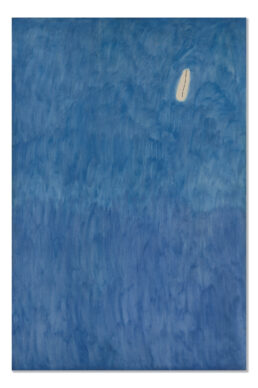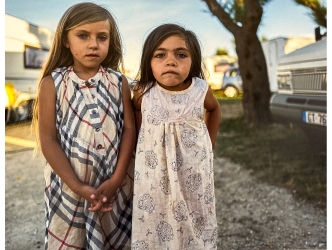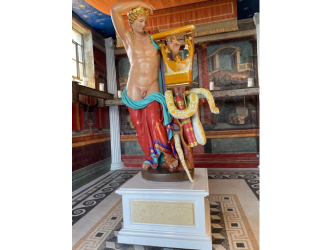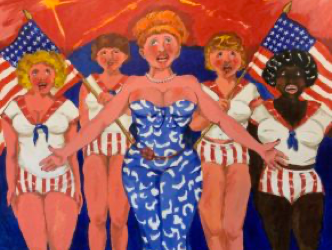Audrey Hepburn
Hubert de Givenchy became a legendary figure thanks to two women. The first, who is the embodiment of cinematic grace, is Audrey Hepburn, for whom he designed the legendary silhouettes worn in films she starred in as the delightful heroine, like Funny Face and Breakfast at Tiffany’s.
Bunny Mellon

Hôtel de Beauffremont
The second is Bunny Mellon (1910-2014), a rich Washington collector for whom he created an abundance of haute-couture clothing. (In 2014 Sotheby’s sold part of Bunny Mellon’s art collection for 157 million dollars). It was thanks to her that very early on he became interested in the American painter Mark Rothko, as he told me in an interview from 2007.
First a Rothko

Château du Jonchet
“The first contemporary artwork I bought was a painting by Rothko. The artist had just died, and my friend Bunny suggested we go and visit his studio. She bought 14 canvases from the 800 works contained in this former stable from the 1800s. I got one myself, a large-scale piece in tones of green, purple and red.”
This is how Bunny Mellon’s support would allow the Givenchy couture house to grow rapidly.
Impulses

‘Bunny Mellon’ Bedroom
In his private life this art lover had a large appetite. He qualified this by saying: “I am not a collector. I act on impulses. I assemble objects and I live with them. My goal is not to accumulate. I had a friend, Balenciaga, who collected cup-and-ball toys. In ivory, in wood… An entire table of cup-and-ball toys from all eras, it was beautiful. But I’m not so sure I’d have the patience to do it.”
Selling and buying a lot
Givenchy bought a lot to decorate his interiors. He had a townhouse in Paris, the Hôtel de Beauffremont in the 7th arrondissement and a large manor house in the Val de Loire. But he also sold a lot.

Hôtel de Beauffremont
4 Rothkos
In 1993, in order to acquire an extra floor of his Parisian residence, he gave up various key pieces from his collection, including 4 Rothkos as well as 97 lots of furniture and art objects. It was a resounding success. Louis XIV style furnishings were back in fashion.
Miro

Juan Miro
That same year, he sold an exceptional Miro to the Centre Pompidou a painting entitled “Bleu 1”, measuring 3.5 metres long, which is part of a famous abstract triptych from 1961 (An other Miro, smaller is in the 2022 catalogue). In 2017 he also parted with 21 pieces in bronze and plaster by Diego Giacometti, superstar of the decorative arts from the 20th century and brother of the sculptor Alberto, for 32 million euros.
Hubert de Givenchy died in 2018. His life partner was Philippe Venet, himself a couturier, who died in 2021.
Impressive inventory
From 14 to 17 June Christie’s is dispersing the contents of the couple’s two homes in huge wide-ranging sales with the addition of online auctions from 14 to 17 June. 1229 lots. 440 armchairs. Around one hundred sculptures… The inventory is impressive. The general tone of the catalogues is fairly classical in nature.

Charles Cator
“He had an eye for mixing eras. He was very strict about his living arrangements and would always choose architectural furnishings,” observes Charles Cator, vice-president of Christie’s international. The sale on 14 June is composed of what Christie’s calls masterpieces.
Alberto Giacometti

Alberto Giacometti
The star piece is a bronze sculpture by Alberto Giacometti made between 1932 and 1936, “Femme qui marche II”. Conceived in four copies, it stands 1.5 metres tall and is estimated at the colossal sum of 30 million euros. It was made when the artist was at a turning point, transitioning away from surrealism and conceiving for the first time an elongated form of sculpture, although it had a smooth and well-rounded look contrary to his postwar work which would make him famous. Only one other comparable work has been presented at auction. This was in 1994. It was sold for the equivalent of 765,000 euros. Hubert de Givenchy acquired this sculpture in the 1970s through Bunny Mellon.

Hôtel de Beauffremont
François de Ricqlès
The private dealer François de Ricqlès, who knew him well, described his “unique taste, with no frills. He had a good sense of the houses and what objects would go within them. At his home in Paris, in the first living room for example, he had placed opposite the Alberto Giacometti sculpture a large drawing by Picasso and in the next room an enormous Louis XVI chandelier.”
Major Picasso drawing

Pablo Picasso
The major work on paper by the master of Malaga, measuring 164 x 131cm and made in 1947 in Antibes, has an estimate of 1.5 million euros. The vast majority of the pieces presented are examples of 18th-century furniture, a market that has been experiencing a noticeable slowdown over the past twenty or so years.
18th-century furniture

The specialist antiques dealer based in Paris and London, Philippe Perrin, explains: “the average price band for objects has dropped by at least 50% but the exceptional pieces, which have become extremely rare, sell for large sums, perhaps even larger than in the past.”
Qatari collector
Major transactions have taken place in this field in recent years, such as the very discreet sale by New York investor Henry Kravis of his collection of 18th-century furniture to the famous art enthusiast from Qatar, Sheikh Hamad bin Abdullah Al Thani (See here the report about his collection of masterpieces at Hotel de la Marine, in Paris).
Cylinder desk

David Roentgen et François Remond
One of the most anticipated pieces of furniture in the Givenchy sale is a cylinder desk from the Louis XVI era, dating from around 1780 with an estimate of 500,000 euros. With a veneer of mahogany from Saint Domingue it was designed jointly by cabinetmaker David Roentgen and bronze gilder François Rémond. It presents the particular feature of sophisticated mechanisms which reveal six secret drawers. The experts at Christie’s suspect a royal provenance for this exceptional piece. Charles Cator points out that a comparable model can be found in Buckingham Palace.
Greek-Inspired
The other star lot (estimate: 600,000 euros) is a flat-topped desk (“bureau plat”) from the end of the Louis XV era with a veneer of Indian ebony decorated with Greek-inspired gilded bronze features. It is attributed to the German cabinetmaker who lived in Paris, Joseph Baumhauer.
Reputation effect

Christie’s is counting on the “reputation effect” of the Givenchy sale to push up the prices for this large quantity of pieces, which are not all sought after, having been put on the market. To reach the wider public part of the auction will even take place, as a one-off, at the Théâtre Marigny on the Champs Elysées. It remains the be seen whether the decorative arts from the 18th century will be able to find their audience after falling out of fashion.
Souvenir of the great Givenchy taste
A stool in Italian leather from the late 18th century (estimate: 4000 euros), a German silver sculpted dog from the late 19th century (estimate: 3000 euros) and two silver tastevins of the same origin from the 17th century (estimate: 1500 euros) … Certain estimates are set to attract bidders who might like a souvenir of the great Givenchy taste.
Donating=Supporting

Support independent news on art.
Your contribution : Make a monthly commitment to support JB Reports or a one off contribution as and when you feel like it. Choose the option that suits you best.
Need to cancel a recurring donation? Please go here.
The donation is considered to be a subscription for a fee set by the donor and for a duration also set by the donor.




